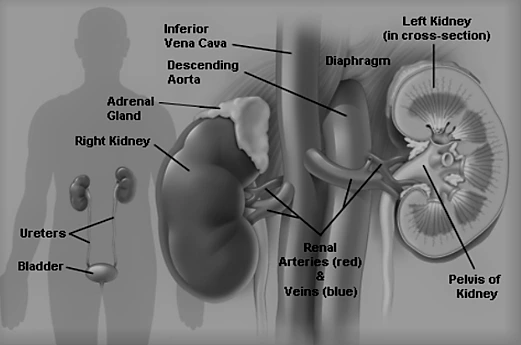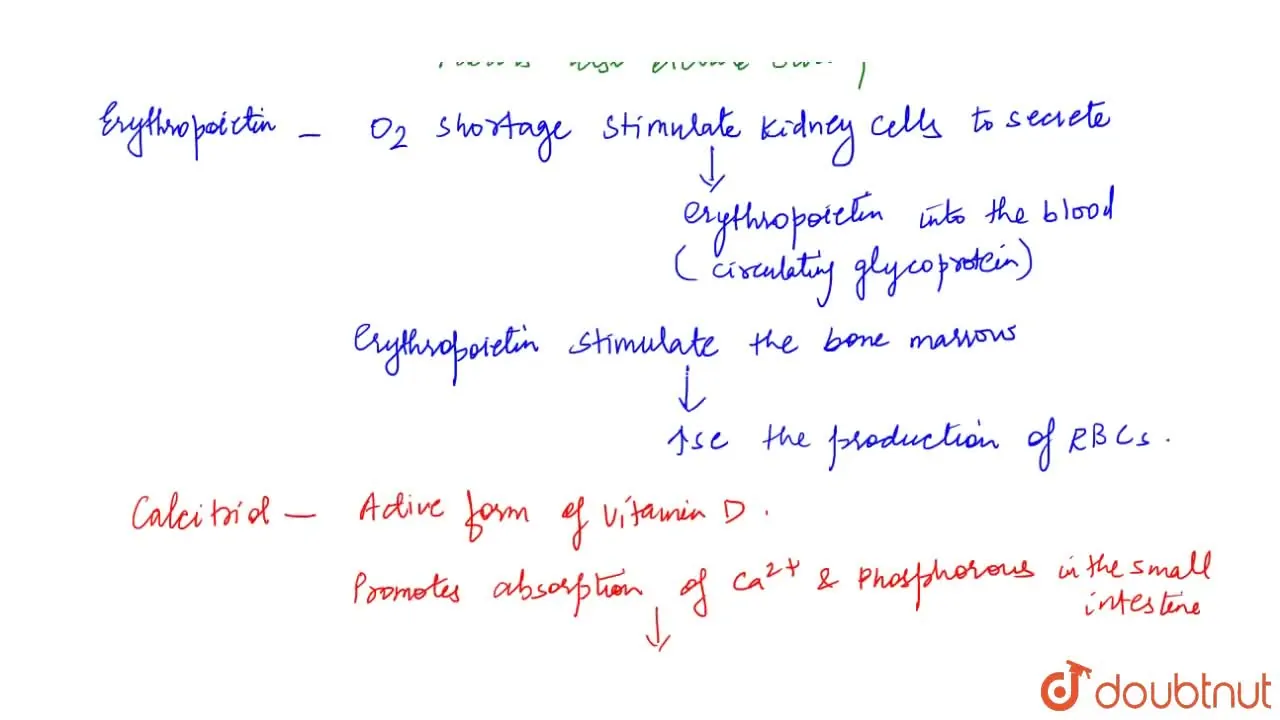Kidney
Kidney
In this chapter, we will learn about kidney and its functions. The kidneys are two bean-shaped that are found in the renal system. It helps the body in passing body waste in the form of urine. It also helps in filtering blood before it sends back to the heart. There are many functions of the kidney that includes filtering and regulating minerals from the blood, maintaining the overall fluid balance, etc. It also helps to filter waste materials from medications, food as well as toxic substances. Further, kidneys create hormones that make it possible in producing red blood cells, regulate blood pressure, and also promote bone health.
Functions of kidney
Let us study the functions of the kidney as below:

-
Nephrons: The most important part of each kidney are the nephrons. The main function of nephron is taking blood, metabolizing nutrients and passing out waste products from filtered blood. It is interesting to note that there are about 1 million nephrons in each kidney.
-
Renal corpuscle: Blood goes into the renal corpuscle after entering nephron. This is known as a Malpighian body. There are two additional structures of the renal corpuscle that includes;
-
The glomerulus: There is a presence of a cluster of capillaries, where protein from blood is absorbed, that passes through the renal corpuscle.
-
The Bowman capsule: The Bowman capsule is passed by the remaining fluid, which is called capsular urine.
-
Renal tubules: The series of tubes that begin after the Bowman capsule are the renal tubules. It ends at collecting ducts. There are several parts in each tubule which are as follows:
-
Proximal convoluted tubule: This part helps in absorbing sodium, water, and glucose back into the blood.
-
Loop of Henle: This section helps to absorb sodium, chloride, and potassium into the blood.
-
Distal convoluted tubule: More sodium is absorbed by this section into the blood where acid and potassium are taken in.
The fluid gets diluted and filled with urea by the time it reaches the end of the tubule. Urea is released in urine which is byproducts of protein metabolism.
-
Renal cortex: The outer part of the kidney is the renal cortex. It contains the convoluted tubules and glomerulus. The renal cortex surrounds the renal cortex on its outer edges which is a layer of fatty tissue. The inner structures of the kidney are protected by the renal cortex and capsule house.
-
Renal medulla: The smooth and inner tissue of the kidney is called the renal medulla. Here, it contains the loop of Henle and real pyramids.
-
Renal pyramids: There are small structures where it contains the strings of tubules and nephrons, which are known as renal pyramids. These tubules help in transporting fluid into the kidney.
-
Collecting ducts: At the end of each nephron, there is a collecting duct in the renal medulla. So, the fluid moves on to its final stops once in the collecting duct.
-
Renal Pelvis: It is a funnel-shaped space that is located in the innermost part of the kidney. Its main role is to act as a pathway for fluid to the bladder.
-
Calyces: Calyces are the first part of the renal pelvis. It collects fluids before moving into the bladder. So, here the extra waste and fluid become urine.
-
Hilum: On the inner edge of the kidney, there is a small opening which is called the hilum. It curves inward in creating its distinct bean-like shape. The renal pelvis passes through the:
-
Renal artery: Here, the oxygenated blood is brought from the heart to the kidney for filtration.
-
Renal vein: Here, the filtered blood is carried from the kidneys back to the heart.
-
Ureter: It is a tube of muscle where urine is pushed into the bladder. Here, ureter collects the urine and exits the body.
What are the Symptoms of Kidney Problems?
The different symptoms of kidney problems are:
-
Foamy urine: When protein leaks into the urine, it becomes foamy. In this case, you can see excessive bubbles in the urine even after flushing a lot of time. So, this indicates that you have a problem with your kidney.
-
Itchy and dry skin: The kidney does a lot of important jobs where it helps in making red blood cells. It also helps in removing wastes and extra fluid from your body. This, in turn, leads to dry and itchy skin.
-
Trouble in sleeping: The kidneys do not get filtered properly because the toxins stay in the blood. This makes it difficult to get adequate sleep. So, people suffering from kidney problems are prone to sleep apnea.
-
Poor appetite: Another sign of a poor kidney function is the loss of appetite. It builds up toxins which in turn lead to this condition. People who suffer from kidney problems lack the taste of food and the craving for the same also diminishes.
-
Foot or ankle swelling: Due to the decrease in the function of the kidney, it leads to sodium retention, which causes your ankle and feet to swell. So, it can be a sign of heart disease or liver disease if you notice a swelling in the lower extremities.
-
Muscle cramps: When a kidney is damaged, it results in electrolyte imbalance. So, this leads to cramping of muscles due to low levels of calcium as well as poorly controlled phosphorous.
-
The need to urinate more often: The need to urinate more often is another sign of kidney disease is. In this case, an individual urge to urinate more. But, in some cases, this can also be due to the enlarged prostate or urinary infection in men.
-
Blood in the urine: The blood cells in the body start to leak out into the urine when the filters of the kidney get damaged. Here, blood in the urine indicates kidney stones, tumours, or even an infection.
-
Other symptoms: Other symptoms exist which include the following:
- increased or decreased urination
- reduced appetite
- fatigue
- inability to concentrate
- puffiness around the eyes
Important Chapters:

Nephrons: The most important part of each kidney are the nephrons. The main function of nephron is taking blood, metabolizing nutrients and passing out waste products from filtered blood. It is interesting to note that there are about 1 million nephrons in each kidney.
Renal corpuscle: Blood goes into the renal corpuscle after entering nephron. This is known as a Malpighian body. There are two additional structures of the renal corpuscle that includes;
The glomerulus: There is a presence of a cluster of capillaries, where protein from blood is absorbed, that passes through the renal corpuscle.
The Bowman capsule: The Bowman capsule is passed by the remaining fluid, which is called capsular urine.
Renal tubules: The series of tubes that begin after the Bowman capsule are the renal tubules. It ends at collecting ducts. There are several parts in each tubule which are as follows:
Proximal convoluted tubule: This part helps in absorbing sodium, water, and glucose back into the blood.
Loop of Henle: This section helps to absorb sodium, chloride, and potassium into the blood.
Distal convoluted tubule: More sodium is absorbed by this section into the blood where acid and potassium are taken in.
Renal cortex: The outer part of the kidney is the renal cortex. It contains the convoluted tubules and glomerulus. The renal cortex surrounds the renal cortex on its outer edges which is a layer of fatty tissue. The inner structures of the kidney are protected by the renal cortex and capsule house.
Renal medulla: The smooth and inner tissue of the kidney is called the renal medulla. Here, it contains the loop of Henle and real pyramids.
Renal pyramids: There are small structures where it contains the strings of tubules and nephrons, which are known as renal pyramids. These tubules help in transporting fluid into the kidney.
Collecting ducts: At the end of each nephron, there is a collecting duct in the renal medulla. So, the fluid moves on to its final stops once in the collecting duct.
Renal Pelvis: It is a funnel-shaped space that is located in the innermost part of the kidney. Its main role is to act as a pathway for fluid to the bladder.
Calyces: Calyces are the first part of the renal pelvis. It collects fluids before moving into the bladder. So, here the extra waste and fluid become urine.
Hilum: On the inner edge of the kidney, there is a small opening which is called the hilum. It curves inward in creating its distinct bean-like shape. The renal pelvis passes through the:
Renal artery: Here, the oxygenated blood is brought from the heart to the kidney for filtration.
Renal vein: Here, the filtered blood is carried from the kidneys back to the heart.
Ureter: It is a tube of muscle where urine is pushed into the bladder. Here, ureter collects the urine and exits the body.
Foamy urine: When protein leaks into the urine, it becomes foamy. In this case, you can see excessive bubbles in the urine even after flushing a lot of time. So, this indicates that you have a problem with your kidney.
Itchy and dry skin: The kidney does a lot of important jobs where it helps in making red blood cells. It also helps in removing wastes and extra fluid from your body. This, in turn, leads to dry and itchy skin.
Trouble in sleeping: The kidneys do not get filtered properly because the toxins stay in the blood. This makes it difficult to get adequate sleep. So, people suffering from kidney problems are prone to sleep apnea.
Poor appetite: Another sign of a poor kidney function is the loss of appetite. It builds up toxins which in turn lead to this condition. People who suffer from kidney problems lack the taste of food and the craving for the same also diminishes.
Foot or ankle swelling: Due to the decrease in the function of the kidney, it leads to sodium retention, which causes your ankle and feet to swell. So, it can be a sign of heart disease or liver disease if you notice a swelling in the lower extremities.
Muscle cramps: When a kidney is damaged, it results in electrolyte imbalance. So, this leads to cramping of muscles due to low levels of calcium as well as poorly controlled phosphorous.
The need to urinate more often: The need to urinate more often is another sign of kidney disease is. In this case, an individual urge to urinate more. But, in some cases, this can also be due to the enlarged prostate or urinary infection in men.
Blood in the urine: The blood cells in the body start to leak out into the urine when the filters of the kidney get damaged. Here, blood in the urine indicates kidney stones, tumours, or even an infection.
Other symptoms: Other symptoms exist which include the following:
- increased or decreased urination
- reduced appetite
- fatigue
- inability to concentrate
- puffiness around the eyes


